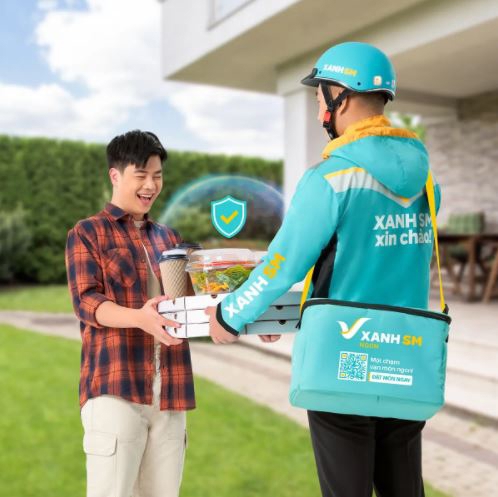Xanh SM officially launched its Xanh SM Ngon service in Hanoi in June, partnering with more than 2,000 restaurants and eateries. The service is set to expand to Ho Chi Minh City in July and to many other cities and provinces later in the year. “Following on from the success of our previous electric vehicle services, Xanh SM Ngon is the next step in perfecting our service ecosystem, addressing daily essential needs with three key pillars: speed, food quality, and user experience,” said Ms. Nguyen Ngoc Thuy Linh, CEO of Xanh SM Vietnam.
Vietnam is one of the fastest-growing food delivery markets in Southeast Asia, with a projected compound annual growth rate (CAGR) of nearly 13 per cent between 2024 and 2029, according to a report from Mordor Intelligence. “Demand is not only coming from large cities such as Hanoi and Ho Chi Minh City but also from localities such as Hai Phong, Da Nang, and Quang Ninh, among others,” she added.
Dynamic market
According to another report from Singapore’s Momentum Works, Vietnam and Indonesia have become two key regional markets, playing an important role in the strong recovery of the food delivery industry throughout Southeast Asia after a period of slow growth over the past two years. Specifically, total transaction value in the food delivery industry in Vietnam last year was estimated at $1.8 billion, with growth of 26 per cent, mainly attributed to the expansion of customer segments, service areas, and the business ecosystems of food delivery platforms.
According to Mr. Ma Tuan Trong, Head of Country Commercial at Grab Vietnam, food delivery is no longer just about ordering meals - it has become an essential part of daily life. Consumers are using platforms to explore culinary experiences in personalized ways. “This reflects a clear shift in consumer behavior among Vietnamese users,” he said. “Vietnam boasts a young population, rapid urbanization, and vibrant economic activity in major cities, which collectively create a strong foundation for the expansion of convenience-oriented habits like food delivery.”
Ms. Hoai Anh, Head of Campaign at ShopeeFood Vietnam, said that since ShopeeFood’s entry into the market it has observed truly explosive growth within the food delivery sector. This accelerated trajectory has been particularly evident over the past five to seven years, significantly propelled by the Covid-19 pandemic, which rapidly transformed online food delivery into an essential daily service. Recent reports confirm this robust momentum, underscoring the extensive opportunities available to all market participants.
Vietnam’s food delivery market is indeed witnessing strong growth, driven by a range of factors. Specifically, Ms. Anh pointed out that the demographic profile is exceptional. Vietnam boasts a young, tech-savvy, and rapidly-urbanizing population, meaning consumers are not just open to but actively embrace digital services. They are the ideal audience for platforms like ShopeeFood, and eager to integrate online food delivery into their daily lives. Vietnamese consumers, in general, also exhibit remarkable digital fluency. They are frequent users of apps and consistently eager to explore new digital experiences.
In Vietnam, the food delivery market is also uniquely shaped by the country’s rich culinary heritage and vibrant street food culture, which encourages diverse menu offerings, according to a Statista report. “From the incredible variety of street food to the strong demand for convenient and delicious meals, Vietnam’s culinary heritage perfectly aligns with the convenience that food delivery offers,” Ms. Anh said. “This deep appreciation for food naturally drives high consumer engagement with our services.”
Mr. Trong added that the country’s increasing popularity among international and domestic travelers opens up significant growth potential for the food and beverage sector, including food delivery. By effectively tapping into the tourist segment, which typically shows high demand for unique culinary experiences both offline and online, food delivery platforms can further expand their business while helping promote local cuisine.
Statista’s report also noted that the online food delivery market in Vietnam is significantly influenced by macro-economic factors such as economic growth, urbanization, and disposable income levels. As Vietnam’s GDP continues to rise, increased consumer spending power fuels demand for convenient dining options. Fiscal policies supporting e-commerce and technology adoption also enhance market accessibility.
Competition heats up
Vietnam’s food delivery market is entering a period of intensification. According to Momentum Works, Grab and ShopeeFood still maintain a duopoly in the market. Grab leads with a 48 per cent market share, only slightly higher than ShopeeFood’s 47 per cent. Meanwhile, the market has also seen the withdrawal of many international unicorns such as Baemin, Toss, Zoomcar, and Atome - who exited one after another after competing but failing to achieve the desired results.
Research from Grab noted that every market comes with its own set of challenges, and in Vietnam, macro-economic factors are influencing consumer behavior. In response, Grab has introduced a range of affordable solutions to ensure that users across different income levels and needs can continue to access and benefit from their services “We have also observed that outside of key cities like Hanoi and Ho Chi Minh City, some merchant partners in newly-expanded markets are still unfamiliar with or not yet fully utilizing the digital marketing tools we provide,” said Mr. Trong. “It’s important for us to improve this through more training, better guidance, and on-the-ground support to help these partners undergo a successful digital transformation - ultimately enabling them to reach more customers and grow sustainably.”
While incredibly optimistic about the opportunities in the Vietnamese market, ShopeeFood is also keenly aware that the country presents its own distinct set of challenges. One of the most critical is the ever-evolving and continuously increasing expectations of consumers. As Vietnamese users become more accustomed to the speed and convenience that digital services offer, their demand for everything from food quality and delivery speed to the overall user experience are constantly rising. This isn’t just about “fast” anymore; it’s about seamlessness, reliability, and delight at every touchpoint. “Our strategy revolves around several key pillars: we are consistently improving our service quality, relentlessly enhancing our operational efficiency, and continually introducing new features and innovative initiatives,” said Ms. Anh. “Our ambition is not just to meet these growing expectations, but to consistently exceed them and provide an even more unparalleled and enjoyable experience for all our users in Vietnam. This commitment to continuous improvement is what we believe will set us apart and drive sustainable growth.”
According to Ms. Linh, costs and promotions remain significant challenges, as consumers are still heavily influenced by prices and short-term incentives. This forces platforms to spend aggressively to retain customers, further thinning profit margins. Meanwhile, the process of connecting restaurants, coordinating drivers, controlling quality, and handling payments creates a complex and high-cost logistics system. Platforms compete on prices, restaurant discounts, and driver bonuses, leading to pressure to balance the interests of all three parties.
However, instead of choosing the short-term “money-burning” path, Xanh SM Ngon has declared a commitment to a slow but steady strategy, focusing on operational efficiency, service quality, and user experience. “With the advantage of our existing operational infrastructure, technology, and integrated ecosystem, we will invest in long-term experiences: choosing high-standard restaurant partners, shortening the food journey, optimizing driver productivity, and operating with electric vehicles to reduce costs and be environmentally-friendly,” Ms. Linh said.









 Google translate
Google translate